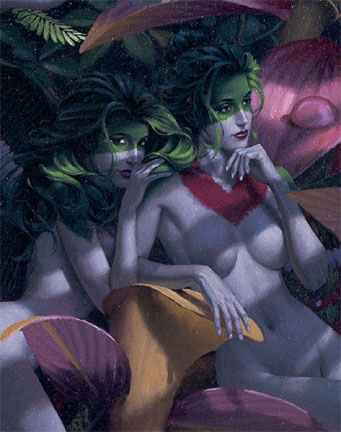|
- Song of the Hummingbird Muses - Sometimes when walking through the forest I make very slow progress, not wanting to miss some foliaceous treasure hidden within the forest undergrowth. As dancing rays of sunlight search through the shimmering vaults of the forest cathedral, one almost seems to hear the windy voices of a choir, angels of nature, permeating that sacred place with song. Who is it that sings with such irresistible beauty, inviting the intrepid into discovery? I call these mythological beings Zoanthropia Musaicum (animal-human mosaic), and they represent the unseen relation between us and the rest of the natural world. The hybridization of forms is a way of portraying the invisible integration that binds all living things together into a larger entity: sometimes called the biosphere, or Gaia. We are beginning to understand the astounding genetic unity in the apparent morphological diversity of nature; someday perhaps we will actually feel the intimate kinship we share with all terrestrial life. We might even find, in that profound perception, the picture formed by all the perfectly interlocking jigsaw pieces of the world’s living puzzle: the image of the true poetry of the world and a knowledge of the destiny of life and consciousness in the cosmos. But poetry, the distillation of experience to its essential magic, is a mysterious form of perception, often happening, it sometimes seems, of its own deeply hidden volition, and only in accord with its own inscrutable objectives. Where then shall we look for the ethereal messenger that brings the miraculous boon of inspiration? |
 |
